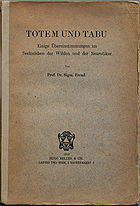- Totem and Taboo
-
Totem and Taboo: Resemblances Between the Mental Lives of Savages and Neurotics is a book by Sigmund Freud published in German in 1913 under the title Totem und Tabu: Einige Übereinstimmungen im Seelenleben der Wilden und der Neurotiker. It is a collection of four essays first published in the journal Imago (1912–13) employing the application of psychoanalysis to the fields of archaeology, anthropology, and the study of religion. The four essays are entitled: The Horror of Incest; Taboo and Emotional Ambivalence; Animism, Magic and the Omnipotence of Thoughts; and The Return of Totemism in Childhood.
Contents
The horror of incest
The first and shortest of the four essays concerns incest taboos adopted by societies believing in totemism.
Freud uses examples mostly from the Australian Aborigines, gathered and discussed by anthropologist James George Frazer. He points out, with some surprise, that although the Aborigines do not seem to have any sexual restrictions, there's an elaborate social organization whose sole purpose is to prevent incestuous sexual relations.
Freud discusses various ways in which the exogamy of the totem system prevents incest not only among the nuclear family, but among extended families as well. In addition, the totem system prevents 'incest' among members of the same totem clan who are not related by blood and considers as incest relations between clan members which could not produce children. He explains that the existence of marriage restrictions between the members of the same tribes probably goes back to when group marriages were allowed (but not 'incest' within a group family).
He concludes the essay with a discussion of the mother-in-law taboo, and concludes that the incestuous wishes which are repressed to the unconscious among civilized peoples are still a conscious peril to the uncivilized people in Frazer's studies.
Taboo and emotional ambivalence
In this essay, Freud considers the relationship of taboos to totemism. Freud uses his concepts 'projection' and 'ambivalence' he developed during his work with neurotic patients in Vienna to discuss the relationship between taboo and totemism.
Like neurotics, 'primitive' peoples feel ambivalent about most people in their lives, but will not admit this consciously to themselves. They will not admit that as much as they love their mother, there are things about her they hate. The suppressed part of this ambivalence (the hate parts) are projected onto others. In the case of natives, the hateful parts are projected onto the totem. As in: 'I did not want my mother to die, the totem wanted her to die.'
Freud expands this idea of ambivalence to include the relationship of citizens to their ruler. In ceremonies surrounding kings, which are often quite violent, – such as the king starving himself in the woods for a few weeks – he considers two levels that are functioning to be the "ostensible" (i.e., the king is being honored) and the "actual" (i.e., the king is being tortured).
Animism, magic and the omnipotence of thought
The third essay examines the animism and narcissistic phase associated with a primitive understanding of the universe and early libidinal development. A belief in magic and sorcery derives from an overvaluation of psychical acts whereby the structural conditions of mind are transposed onto the world: this overvaluation survives in both primitive men and neurotics. The animistic mode of thinking is governed by an "omnipotence of thoughts", a projection of inner mental life onto the external world. This imaginary construction of reality is also discernible in obsessive thinking, delusional disorders and phobias. Freud comments that the omnipotence of thoughts has been retained in the magical realm of art. The last part of the essay concludes the relationship between magic (paranormal), superstition and taboo, arguing that the practices of animistic system are scree behind which lies instinctual repression.
The return of totemism in childhood
In the final essay, Freud argues that combining one of Charles Darwin's more speculative theories about the arrangements of early human societies (a single alpha-male surrounded by a harem of females, similar to the arrangement of gorilla groupings) with the theory of the sacrifice ritual taken from William Robertson Smith located the origins of totemism in a singular event, whereby a band of prehistoric brothers expelled from the alpha-male group returned to kill their father, whom they both feared and respected. In this respect, Freud located the beginnings of the Oedipus complex at the origins of human society, and postulated that all religion was in effect an extended and collective form of guilt and ambivalence to cope with the killing of the father figure (which he saw as the true original sin).
See also
External links
- Totem and Taboo on Wikisource
- Extracts from Totem and Taboo
- Totem und Taboo German edition, Open Library
Categories:- 1913 books
- Books by Sigmund Freud
- Freudian psychology
- Psychology books
- Cultural studies books
- Taboo
Wikimedia Foundation. 2010.

